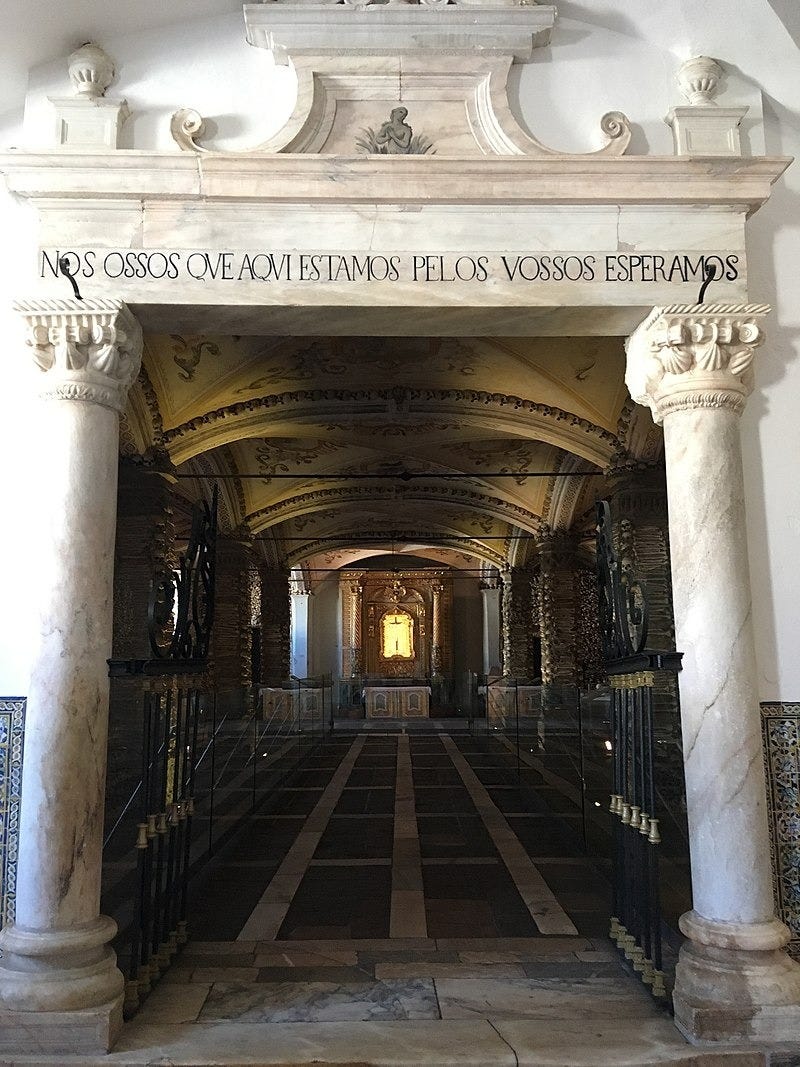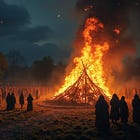The Bones That Await Us: Dying to the fullest
Memento mori in the shadow of the cross
There is a chapel in Évora, Portugal, the Capela dos Ossos, whose very walls are lined with the dead. Skulls gaze blankly from the pillars, femurs lie stacked like cordwood, a macabre tapestry woven from human remains. Above the entrance is inscribed a stark warning and a strange invitation: “Nós ossos que aqui estamos pelos vossos esperamos.”
"We bones, lying here bare, await yours."
This chilling message confronts us with the truth that has shadowed human consciousness since we first understood the concept of an end: mortality is not an abstract possibility of a far-off future, but a shared, inevitable destination that can be very real today.
This awareness, this spectral companion to our existence, has inevitably shaped us. Death has been a human obsession, driving expressions in art, philosophy, and faith for millennia. Yet, our responses to it have been starkly diverse.
Some groups of people, rather than flinching, choose to meet it head-on, even to celebrate it. Consider Mexico's Día de Muertos (Day of the Dead), a festival that floods cemeteries with marigolds, music, and feasting, domesticating the morbid, inviting the departed back into the fold of the living for a brief, joyous reunion. It's a conscious act of shining daylight on what many others prefer to keep unmentioned.
This impulse finds echoes in the philosophical tradition of memento mori—“remember you must die”—a recurring motif stretching back to classical antiquity, urging awareness not as a morbid fixation, but as a catalyst for living well.
Even religious traditions that are often perceived to focus solely on life contain profound meditations on death. The Christian observance of Holy Week (which the world is celebrating this week) obviously culminates in the bright festival of Easter as the major event—but it is too tempting, too easy, to focus on the triumph over darkness at the risk of glossing over the darkness itself. To fully appreciate the triumph of life, we must first fully appreciate the reality and depth of the darkness.
The spirit of the Easter season pulses with the chill of death, actually beginning weeks earlier with Ash Wednesday where streaks of ashes are placed on one's forehead in the sign of a cross—accompanied by the words, "Remember, Man, that you are dust, and unto dust you shall return." It is a deep contemplation of mortality, and the implied question is, "How will you live rightly in the time you have left?"
But facing death, truly facing it, is unsurprisingly repulsive. While some cultures build festivals around it and philosophies encourage its contemplation, a powerful countercurrent runs through the human psyche: the urge to flee, to deny, to distract ourselves from that looming reality. Especially in our modern societies of convenience and comfort, we have removed almost all opportunity to contemplate death. Terror Management Theory posits that this fundamental fear of death is a primary engine driving human behavior. Much of our striving—our building of monuments, our pursuit of legacy, our creation of complex cultural systems and beliefs—can be understood, at least in part, as an elaborate architecture of distraction from the terror of non-existence and endings. We seek symbolic immortality, weave narratives of meaning, and immerse ourselves in immediate sensations precisely to avoid looking too long into the abyss the Capela dos Ossos represents... or to ensure that we live on in spirit through the legacies of achievements, children, and stone.
But... when the inevitability can no longer be ignored, two classic responses often emerge . The first is the path of the hedonist, encapsulated in the ancient refrain, "Eat, drink, and be merry, for tomorrow we die." If life is fleeting and oblivion awaits, why not seize every available pleasure, indulge every appetite, grasp at fleeting sensation in a fevered embrace of the now? It is a strategy of maximizing the tangible before it vanishes. (Of course, the hedonist is an extreme. There is much to be said for the seizing of the now, Carpe Diem, which is beautifully portrayed in the movie The Dead Poets Society)
The second path is that of the spiritual ascetic. Confronting the same morbid reality of impermanence, the ascetic chooses detachment. Earthly pleasures, achievements, even relationships, are seen as ties binding one to a world destined to fade. They then shift focus to what they deem actually lasting: they look inward and upward, cultivating a disregard for the material in favor of the spiritual, seeking solace in the prospect of an immortal soul or an afterlife.
These divergent paths often correspond to two distinct conceptualizations of death's significance. For some, the finality of death renders everything preceding it ultimately meaningless. (The heat death of the universe is a popular meme to illustrate this sentiment). If all roads lead to dust, then aspirations, struggles, love, and loss amount to little more than a cosmic shrug, sound and fury signifying nothing. The universe is indifferent, and our brief spark is extinguished without consequence, or God cares only about bringing us into an ethereal heaven (by the way, if so, why wouldn't we try to get ourselves there ASAP?).
Yet, for others, the very fact of death imbues life, and even death itself, with the utmost meaning. The scarcity of time makes each moment precious. The awareness of ending lends weight and consequence to our choices. In this view, death is not a negation but a defining parameter, even an enhancer. It is the dark sky against which the diamond of existence gleams all the brighter. It confers a sacred resonance upon the finite.
But here, the Christian narrative, particularly as embodied in the figure of Christ and commemorated in Holy Week, offers a startling, perhaps revolutionary, framing. Unlike traditions that compartmentalize their celebrations—a time for mourning, a time for reveling in life—Holy Week insists on holding both death and life in their fullest intensity, simultaneously, and inextricably. Christ's suffering and death on Good Friday are intrinsically linked to Easter's transformation and rebirth. Two faces of a single, profound phenomenon.
The Resurrection does not erase the Crucifixion. It fulfills it. Furthermore, the Rebirth is made complete only because the Death is complete. Unlike memento mori where death is remembered as a final end, the Christian narrative remembers death as the path to vindication.
How is this possible? How could death, which comes to us all, be vindication? The answer lies not in the fact of one's dying, but in how one dies.
This unification of Crucifixion and Resurrection is significant. It suggests that life and death are not polar opposites locked in eternal conflict, but complementary forces—perhaps even prerequisites for each other's completion. The story of the Passion implies something radical: that life finds its fullest expression not in spite of death, but precisely through its embrace. Christ did not merely succumb to death; he confronted it, walked willingly into its depths, took on its full measure. And it was through this complete shouldering of the weight of Hades that the ultimate affirmation of life became possible. He demonstrated that to truly live, one cannot perpetually flee the shadow, but must, at some level, voluntarily face the depths, to integrate the reality of death into the fabric of being. Life, in this light, is realized not by denying death, but by transfiguring it through courageous sacrifice.
This is how we vindicate our existence in a broken world. This is the closest we can get to creating something truly lasting in a world of impermanence.
The figure of Christ, therefore, teaches us something crucial about navigating our own mortality and the metaphorical deaths we encounter throughout life—the deaths of ego, of illusions, of old selves and dispositions. It suggests that the richest, most meaningful existence is attained not by hoarding life or shying away from sacrifice (as the hedonists do), but by choosing to aim up, to embody self-sacrificial love, and to give one's all for a vision greater than personal comfort.
Make no mistake: this path will lead to the death of ourselves. It commands us, "Memento mori!" for the death of our selfishness, of our fear, and of the small, guarded self. Yet, paradoxically, it is this very willingness to die in the service of something noble, something loving, something generative, that constitutes the life fully and truly lived. And if the Christian story has any truth to it, it is that this is the best possible endeavor for bringing the kingdom of heaven onto earth.
The bones await us all, yes. But the story whispered from the cross and the empty tomb, which we commemorate this week, suggests that how we meet that inevitability—no, that invitation—and how we integrate the awareness of death into the act of living, makes all the difference. For it is in facing the end that we might truly learn how to begin.
Stay purposeful,
Nathanael






